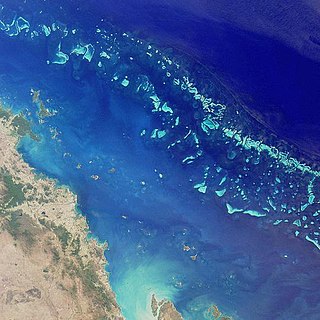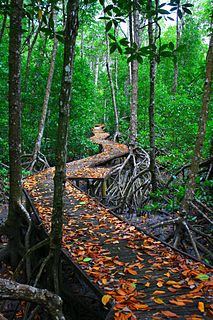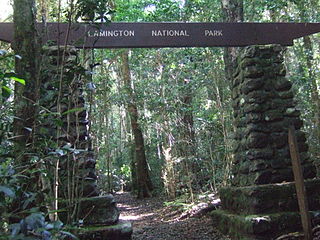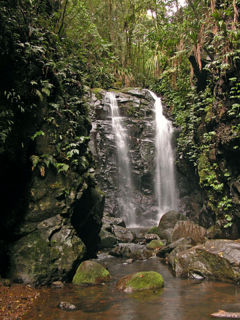| Mount Jim Crow National Park Queensland | |
|---|---|
IUCN category II (national park) | |
Billabong fringed by Melaleuca leucadendra | |
| Nearest town or city | Rockhampton |
| Coordinates | 23°12′53″S150°37′43″E / 23.21472°S 150.62861°E Coordinates: 23°12′53″S150°37′43″E / 23.21472°S 150.62861°E |
| Established | 1977 |
| Area | 1.44 km2 (0.56 sq mi) |
| Managing authorities | Queensland Parks and Wildlife Service |
| See also | Protected areas of Queensland |
Mount Jim Crow National Park is a national park in Queensland, Australia, 531 kilometres (330 mi) northwest of Brisbane.

A national park is a park in use for conservation purposes. Often it is a reserve of natural, semi-natural, or developed land that a sovereign state declares or owns. Although individual nations designate their own national parks differently, there is a common idea: the conservation of 'wild nature' for posterity and as a symbol of national pride. An international organization, the International Union for Conservation of Nature (IUCN), and its World Commission on Protected Areas (WCPA), has defined "National Park" as its Category II type of protected areas.

Queensland is the second-largest and third-most populous state in the Commonwealth of Australia. Situated in the north-east of the country, it is bordered by the Northern Territory, South Australia and New South Wales to the west, south-west and south respectively. To the east, Queensland is bordered by the Coral Sea and Pacific Ocean. To its north is the Torres Strait, with Papua New Guinea located less than 200 km across it from the mainland. The state is the world's sixth-largest sub-national entity, with an area of 1,852,642 square kilometres (715,309 sq mi).

Australia, officially the Commonwealth of Australia, is a sovereign country comprising the mainland of the Australian continent, the island of Tasmania and numerous smaller islands. It is the largest country in Oceania and the world's sixth-largest country by total area. The neighbouring countries are Papua New Guinea, Indonesia and East Timor to the north; the Solomon Islands and Vanuatu to the north-east; and New Zealand to the south-east. The population of 25 million is highly urbanised and heavily concentrated on the eastern seaboard. Australia's capital is Canberra, and its largest city is Sydney. The country's other major metropolitan areas are Melbourne, Brisbane, Perth and Adelaide.
It lies just beside the main road between Rockhampton and Yeppoon. Camping is not permitted in the park and there are no facilities. [1]
The main feature of the park is Mount Jim Crow, a trachyte plug which is a remnant of an extinct volcano. [1]

Trachyte is an igneous volcanic rock with an aphanitic to porphyritic texture. It is the volcanic equivalent of syenite. The mineral assemblage consists of essential alkali feldspar; relatively minor plagioclase and quartz or a feldspathoid such as nepheline may also be present.. Biotite, clinopyroxene and olivine are common accessory minerals.

A volcanic plug, also called a volcanic neck or lava neck, is a volcanic object created when magma hardens within a vent on an active volcano. When present, a plug can cause an extreme build-up of pressure if rising volatile-charged magma is trapped beneath it, and this can sometimes lead to an explosive eruption. Glacial erosion can lead to exposure of the plug on one side, while a long slope of material remains on the opposite side. Such landforms are called crag and tail. If a plug is preserved, erosion may remove the surrounding rock while the erosion-resistant plug remains, producing a distinctive upstanding landform.
The Darumbal people have traditionally regarded Mount Jim Crow as a significance place in their Dreamtime stories. [1]
The Darumbal are the Indigenous Australians that have traditionally occupied Central Queensland, speaking dialects of the Darumbal language. Darumbal people of the Keppel Islands and surrounding regions are sometimes also known as Woppaburra or Ganumi, and the terms are sometimes used interchangeably.

Dreamtime is a term devised by early anthropologists to refer to a religio-cultural worldview attributed to Australian Aboriginal beliefs. It was originally used by Francis Gillen, quickly adopted by his colleague Baldwin Spencer and thereafter popularised by A. P. Elkin, who, however, later revised his views. The Dreaming is used to represent Aboriginal concepts of "time out of time" or "everywhen", during which the land was inhabited by ancestral figures, often of heroic proportions or with supernatural abilities. These figures were often distinct from "gods" as they did not control the material world and were not worshipped, but only revered. The concept of the dreamtime has subsequently become widely adopted beyond its original Australian context and is now part of global popular culture.
















